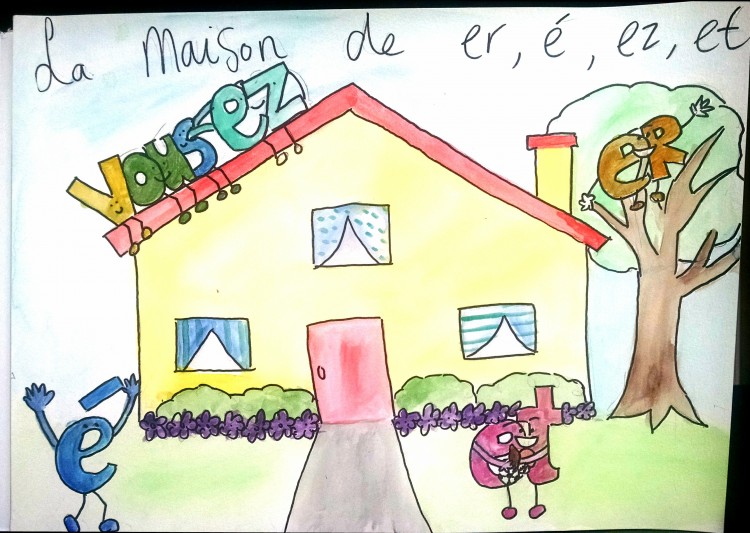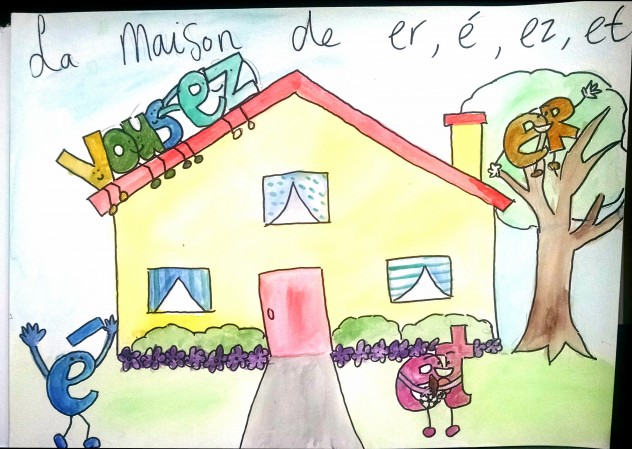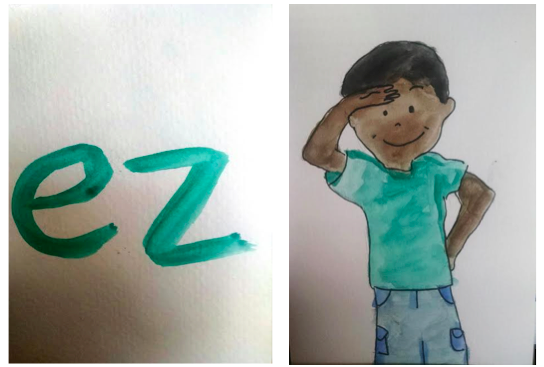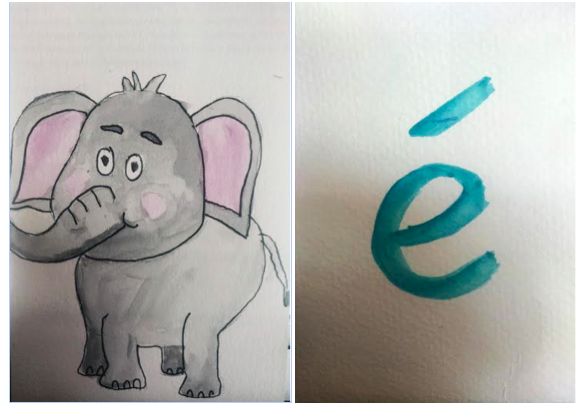(IE MEd Student; French Immersion/FSL Teacher, Victoria, B.C.)
As a second language teacher, I employ different “cognitive tools”, or tools of the imagination, to make language learning more engaging for my students and for myself. This approach is called Imaginative Education and it centralizes students’ emotions in teaching. In this unit on French phonetics I employ an array of cognitive tools. (Be sure to click on each of these “thinking” tools to learn more about it. You may also be interested in this post on Tools of Imagination For Second Language Teaching.)
French phonetics is a topic I used to find rather mundane, but by employing the tools of imagination, I have found joy and humour in this topic and my students are interested and imaginatively engaged.
An Overview
When teaching French phonetics, for example, I employ the story-form tool by telling students of a place called “La Cité des Sons”, a community inhabited by all the sounds in French language. Each lesson, students are introduced to a new sound and will learn about that sound through personalization—through story-form I characterize different aspects of grammer. For example, students will be introduced to ‘t’, a stubborn member of the community who always needs to get his way. He hates being last in line, whenever he is last in a word; he gives everyone the silent treatment. Or, when learning the different spelling for the sound ‘ay’ students are introduced to the restless ER, who is very active and always moving. They learn about EZ, who is best friends with vous, and É who is very sociable, gets along with all of the sounds and is always out and about. And, of course, they learn about ET, who generally stands alone because he is a little greedy; he is never quite satisfied with what he has; you take ET out for dinner and he wants a hamburger AND macaroni and cheese.
Other tools I use in this unit include, for example, the “extremes and limits” cognitive tool. I have my students discover which sound has the most possible spellings, or “siblings” (the sound ‘eh’ e, è, ê, ai, ei, ais, ait, aient) and which sounds have the least. Through the extremes and limits tool students can understand that some sounds only have one letter, while others can have as many as 4! (eaux). I employ the “literate eye” cognitive tool by visually displaying the city around the class and the “collections and sets” tool by having students become an expert on one sound and collect all the words they can find that contain that sound.
Details: Using Cognitive Tools To Teach Phonetics
The Story-Form: In “La Cité des Sons” each sound lives in a different house. Some sounds live alone and some sounds have roommates. The sounds come together and line up in the community to make words. In each lesson, students will be introduced to a new sound and will learn about the characteristic of the sound through personalization. For example, ‘t’ lives alone. He enjoys the company of vowel sounds like ‘a’ ‘i’ ‘e’ ‘é’. ‘T’ is pretty stubborn and always needs to get his way. For example, he hates being last in line, whenever he is last in a word; he gives everyone the silent treatment. The classroom could be set up as the city of sounds, building a new house every time we learn about a new sound. The visual representations would also help students learn the characteristics of the different spellings. For example:
There is a house in la cité des sons that has four occupants. The first, ER, is very active; he’s always moving and is very restless. He loves to danse, chante, saute, grimp. The other thing about ER is he’s always late, and ALWAYS last in line.
The second, EZ, is best friends with Vous, you rarely see Vous without EZ close behind. Whatever Vous is doing, EZ is there. Vous dansez? Vous chantez (sing)? Vous mangez (eat)? Like ER, EZ is always late, always last in line, always last to join a word.
É is everywhere, very sociable, gets along with all of the sounds. You always see é out about. É is very easy going and doesn’t mind who he makes words with or where is in the line. Sometimes he’s first, in the middle or last.
The fourth roommate is ET. The other sounds don’t like to make words with him so he almost always stands alone. He is a little greedy; he is never quite satisfied with what he has. One thing is never enough for ET. You go out to dinner with ET and he wants a hamburger AND macaroni and cheese. If you tell him a story he’s not satisfied with the ending, he’ll ask AND thennnn what?!
Abstract Binary Opposite: There is a dramatic tension playing out throughout my teaching—this makes for an engaging learning context; just like the fairy tales and myths students enjoy. I chose the binary opposite alone/together in this unit to help students to understand that some sounds only have one spelling, while others can have 3 or 4.
Games, Drama, and Play: This memory game is inspired by Tannis Calder’s Sound Card Games presented in the LUCID Oral Language Project (2008).
There are two kinds of cards:
- Picture cards
- ‘ay’ sound cards (é, ez, er and et) *there are multiples of each spelling
The picture cards are white on the back and the sound cards are blue. Students will shuffle all the cards together and lay them out on the table face down. The youngest student will go first and will flip over a white card and a blue card. If the spelling on the sound card matches the spelling of the word on the picture card, the student gets to keep the two cards. For example, if the students flips over a picture of an elephant (éléphant) and the é sound game, the students gets to keep both cards. If the spellings to do not match, the student will put the cards back down where he or she picked them up and it will be the next students turn. For example, if the student picks up the walking (marcher) picture card and the et sound card he or she has to put both cards back. The game will continue until there are no cards left on the table.
A third variation of the game using the same cards is the give each group of students or individual student a é, ez, er, and et card and a set of the picture cards and have them sort the pictures into the correct pile. This way, students are able to see connections between words that have the same spelling. For example, words with the er spelling are verbs: marcher (walk), chercher (look), chanter (sing), manger (eat). Words with ez spelling always have vous and more than one person in the picture and words with é are random: éléphant, écrire, école (elephant, write, school).
Extension: students can create new picture cards to add to the game. This would give students the opportunity to search for words with the ‘ay’ sound and discover which “roommate” is part of that word.
Sense of Mystery/Puzzles: After hearing about new sounds, students can go on a hunt to find the sounds in the books in the classroom. Also, the teacher could explain that something the members of the ‘ay’ house, for example, like to play pranks on other sounds and words by pretending to be each other. Students could be given a few words or sentences with the wrong spelling of a sound and act as detectives trying to solve the puzzle. For example:
Je veux les biscuits ez la crème glacee ez le chocolat. (I want cookies and ice cream and chocolate)
- Vous danset avec un singe. (You dance with a monkey)
- L’erlerphant est grand! (The elephant is big)
- J’aime chantez (I like to sing)
Solving the puzzles will help to solidify their understand of when to which spelling. Why is erlerphant not right? (Because er is always last in line, er in the middle of a word makes ‘ehr’). Why is danset wrong? (Because vous is always with ez, they are best friends)… etc.
Collections & Sets: Students could become an expert on one sound and collect all the words they can find that contain that sound.
Extremes & Limits: Students can discover which sound has the most possible spellings (the sound ‘eh’ e, è, ê, ai, ei, ais) and which sounds have the least. Through extremes and limits students can understand that some sounds only have one letter, while others can have as many as 4! (eaux).
The Literate Eye & Graphic Organizers: The city of sounds can be displayed visually around the class, making it easier for students to see which sounds live in houses alone and which sounds live in houses together.
Engaging The Body: Songs and music can be used to aid students understanding of the sounds. For example, the teacher could play a song and ask students to stand when they hear the sound ‘ch’.
References
Calder, T. (2008, 08). LUCID Oral Language Program. Chilliwack, BC, Canada.
Leave a comment!
Tell us how you engage imagination in your language teaching.





